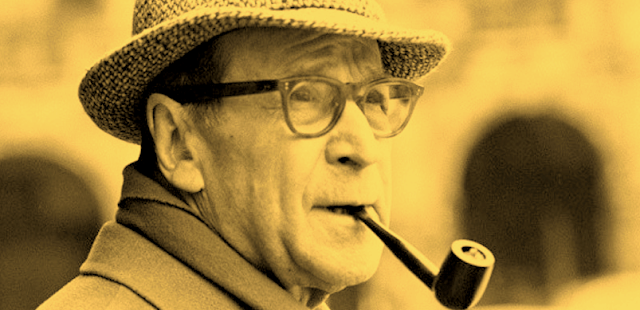On the similarities between impressionist painting and Simenon’s literary output
SIMENON SIMENON. SIMENON E L'IMPRESSIONISMO
A proposito delle somiglianze tra la pittura impressionista e la produzione letteraria di Simenon
SIMENON SIMENON. SIMENON ET L'IMPRESSIONNISME
Simenon-Simenon recently featured a post by Murielle Wenger entitled ‘Ecrire comme un peintre’ (‘Writing like a painter’) in which she argues convincingly that in his use of colour and evocations of the effect of light, Simenon’s style reflects (a loaded term perhaps?) the techniques of the impressionist painters, an influence recognised on several occasions by the author himself. It is interesting to consider other similarities between impressionist painting and Simenon’s literary output.
In their choice of subject matter, the impressionists, like Simenon, drew heavily on the everyday life of the moyenne and petite-bourgeoisie and the environments they depict are often urban landscapes (Sisley’s ‘Canal Saint-Martin’ and Pissarro’s ‘Le Boulevard Montmartre’), railway stations (Monet’s ‘Gare Saint-Lazare’ series), bars (Degas’s ‘L’Absinthe’), nightclubs and dance halls (Manet’s ‘Un Bar aux Folies-Bergères’ and Renoir’s ’Bal au Moulin de la Galette’), the guinguettes on the banks of the Seine (Renoir’s ‘Le déjeuner des canotiers’, Monet’s ‘La Grenouillère’) or seaside resorts and coastal and river ports (Monet’s ‘Jardin à Sainte-Adresse’ and ‘L’Hôtel des Roches Noires’, Pissarro’s studies of Dieppe, Rouen and Le Havre). All of these settings are familiar to readers of Maigret investigations such as Maigret et le corps sans tête, Pietr-le-Letton, Liberty Bar, La Danseuse du Gai Moulin, La Guinguette à deux sous and Au Rendez-vous des Terre-Neuvas amongst others.
A further similarity can be found in the working methods of the painters and the writer. The impressionists often painted in the open air to capture the ambiance of a scene, whereas their predecessors reserved the bulk of their work for the studio. Simenon’s first pulp novel Le Roman d’un dactylo was composed on the terrace of the café Au Rêve, the author claimed to have created the character of Maigret in a bar in the Dutch port of Delfzijl, the action of much of La Tête d’un homme’ takes place in Montparnasse below the windows of the Hôtel Aiglon, where Simenon composed the novel and the authenticity of the descriptions of Port-en-Bessin in La Marie du port owes much to the fact that Simenon wrote the novel while staying in the town at the Hôtel de l’Europe.
Like Simenon, who wrote most of his novels in about ten days with little preparation save a few notes scribbled on a yellow envelope, many of the impressionists worked very quickly and deigned to spend much time revising their work. In Simenon’s case, this sometimes led to careless inconsistencies such as Maigret’s apartment being located in the boulevard Edgar-Quinet in L’Ecluse no. 1, while in the case of the impressionists their hasty composition provoked the accusation that Monet’s ‘Impression, soleil levant’ was at most a sketch, and even supporters such as Zola, judged their work to have an ‘unfinished’ air.
Both the impressionists and Simenon had an ambivalent attitude to the artistic and literary establishments. Manet, although regarded by the Impressionists as their spiritual leader never participated in their exhibitions, preferring to submit his works to the official Salon and urging others to do likewise. First Cézanne, followed by Renoir, Sisley, and Monet, abstained from the group’s exhibitions so they could present their canvases to the Salon. Simenon, although claiming to be indifferent to critical recognition, also secretly craved official acceptance and was bitter at never having been nominated for the Nobel prize.
Yet there are also important differences. For some critics, much impressionist art is superficial, dealing only with visual experience and showing little interest in the lives and problems of real people, a charge that could never be levelled at Simenon. Moreover, impressionist paintings reflect an overwhelmingly optimistic world view, the viewpoint of a rising bourgeoisie, confident in the economic possibilities of capitalism with its attendant urban, industrial, scientific and intellectual advances. Simenon’s ideology, however, is shaped by the Great War, the rise of monopoly capitalism and socialism, and the economic recession of the 1930s. Within this context, Simenon’s own class of origin, the petite-bourgeoisie, felt its economic and social weight to be in decline and much of the author’s pessimism is related to this sense of a perceived existential threat.
William Alder


Nessun commento:
Posta un commento
LASCIATE QUI I VOSTRI COMMENTI, LE VOSTRE IMPRESSIONI LE PRECISAZIONI ANCHE LE CRITICHE E I VOSTRI CONTRIBUTI.